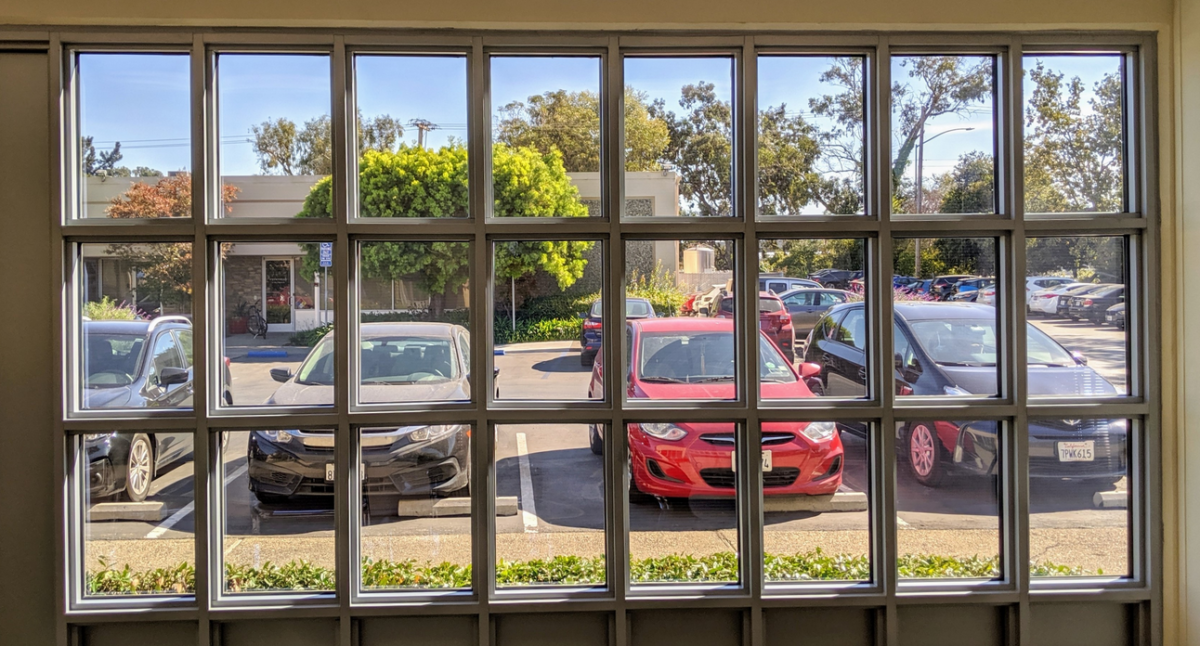From pv magazine USA.
Last year, Ubiquitous Energy claimed a world record for efficiency of a “transparent solar cell” with a “certified” 9.8% power conversion efficiency. According to the startup, the efficiency of the small-sized organic solar cell was certified by third-party test lab Newport Corporation.*
Organic solar cells (OSCs) are lightweight, nontoxic and semi-transparent. They have long-held the promise of low-cost manufacturing, but their efficiencies tend to be low — and their long-term reliability has been questionable.
Ubiquitous Energy deposits organic layers directly on glass using standard glass coating equipment. According to the firm, the transparent solar coating selectively absorbs and converts ultraviolet and near-infrared light to electricity while letting visible light through. The firm is focusing its initial work on architectural glass. The Ubiquitous Energy team holds a number of patents in organic solar cells and graded solar cell technology.
Miles Barr, CTO of Ubiquitous, told Technology Review that it is developing materials that “gather energy deeper into the infrared with nanoscale engineering.”
Ubiquitous Energy has raised more than $25 million from investors such as Riverhorse Investments, Arunas Chesonis, Aberdeen Worldwide Group, Cranberry Capital, along with grants from the National Science Foundation — since being spun-out from the MIT lab of Vladimir Bulović in 2011. Susan Casey Stone, a partner at Riverhorse Investments is CEO, having replaced previous CEO Keith Wilson of Cranberry Capital and Sweetwater Energy.
The firm has installed approximately 100 square feet of transparent solar windows at its headquarters in Redwood City, California as an exterior facing window façade replacing the previous single pane windows.
BIPV is a difficult market to break into
Commercializing an integrated solar facade is not just an engineering problem. It means driving a completely new type of window and curtain wall product through the very conservative building channel — and that’s a daunting marketing challenge. Traditional solar modules on racks may be less than aesthetically perfect, but they have a distribution channel and a solid track record of technical expertise.
Currently, global deployment of OSCs is negligible. Global production capacity amounts to just a few megawatts. OSCs have the lowest efficiency range of any NREL-listed materials system and have not yet delivered on their commercial or cost promise.
If Ubiquitous Energy’s Miles Barr were to respond to pv magazine, we’d ask:
- Is the record 9.8% efficiency test performed at standard test conditions? Tell us more about the record conditions and certifier.
- What efficiency do you think can be expected in a commercial product this year and next?
- What cost metric can you provide? Cost-adder per square-foot?
- What do you figure is the penalty on yield for vertical windows versus flat-panel PV over the course of a year?
- How is power pulled off the individual windows? What is the inverter scheme?
- How do you get the building trade to accept this new type of construction?
- Have you started the UL process for a powered window product?
- Is the entire system cost eligible for the ITC credit?
*Solar efficiency records are typically measured at one of five official test centers: NREL, AIST, PTB, Fraunhofer ISE, and ESTI. There is no category for “transparent solar cell” on the NREL PV record efficiency chart.
***
Current OSC companies
- Heliatek has raised more than $140 million since its founding in 2006 as a spinoff from the Universities of Dresden and Ulm. NREL’s record-keepers have Heliatek at about 10 percent for a single-layer device. Heliatek vacuum deposits layers of small-molecule oligomers at low temperatures in a process that doesn’t use solvents, as printing-based processes do. Heliatek’s funding comes from innogy, Engie, BASF, Stefan Quandt and others. A few years ago, Heliatek’s CEO told this reporter that its fab was producing cells with an efficiency of 8.2% and the next fab would be at 10%. In 2018, the company went through a management change.
- 3GSolar’s DSCs for wireless applications
- Opvius is the former Belectric OPV
- InfinityPV
- Other OSC researchers include Solarmer, Peccell, EPFL, Intel and Mitsubishi
- Oxford Photovoltaics, started with organic solar cells, but soon focused on perovskite materials.
Former OSC companies
- Dyesol claimed to be developing Dye Solar Cell (DSC) technology using a layer of nanotitania on a glass or metal substrate, then claimed to be a perovskite company — and then entered administration.
- Organic solar cell aspirant Konarka raised a great deal of money and went bankrupt without ever making it to commercial production. Its assets were acquired by Belectric.
- Ireland’s SolarPrint spent millions of dollars of investor money on a DSC process before going bankrupt in 2014.
- Eight19 Limited, now dormant, raised $7 million from the Carbon Trust and Rhodia to develop plastic organic solar cells, then switched to working on a “photon multiplier film.”
- Plextronics (bankrupt and sold to Solvay)
This content is protected by copyright and may not be reused. If you want to cooperate with us and would like to reuse some of our content, please contact: editors@pv-magazine.com.




Can be acheived using added solar nano fibers aligned perpendicular to glass surface so that light passes through with fibers absorbing solar energy yet being unseen due to alignment.. Can be aligned magnetically…in north south arangement…
Merck kgaa is also a current OPV company. They bought the Konarka patents and sell the active components to OPV companies such as OPVIOUS (formerly Belectric), Armor, Sunew, etc.